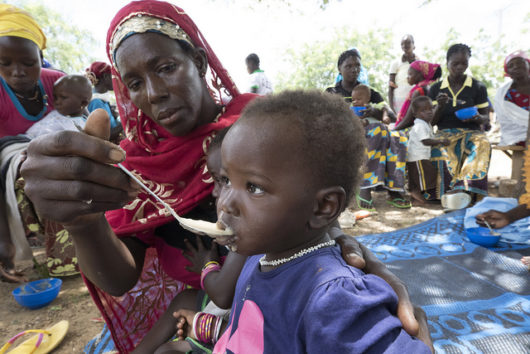Top 10 Facts About Hunger in Burkina Faso

The history of Western Africa country of Burkina Faso is layered with various conflicts and complicated cultural conduits. The desperation and vulnerability accompanying the Sahel region, a region in Africa between the Sahara to the north and the Sudanian Savanna to the south, and the food crisis in the region have affected much of the surrounding area, jeopardizing education, jobs and food security. Being in the middle of the crisis, the people of Burkina Faso have suffered immensely. With developmental assistance and diversification of agricultural exports, the crisis will gradually lessen and the economy will strengthen. In the article below, the top 10 facts about hunger in Burkina Faso are presented.
Top 10 Facts About Hunger in Burkina Faso
- As of 2011, chronic malnutrition in Burkina Faso was at 34 percent and acute malnutrition was over 10 percent. Severe and acute malnutrition rates passed the emergency threshold in some parts of the country recently in relation to the Sahel food crisis. More than 10 percent of Burkina Faso children suffer from acute malnutrition. Another 30.2 percent of children experience growth stunting, a symptom corresponding to malnutrition.
- External debt increased to $3.6 billion in 2018 from $3.2 billion in 2016. Terrorism rose to 4.52 in 2018, the highest index ever recorded for the nation. Security in the country is frequently linked to limited employment availability, poverty, hunger and desperation.
- Though Burkina Faso experienced a boost of gross national income of 95.3 percent between 1990 and 2017 due partly to increased cotton production, it remains among the 10 poorest countries in the world. Around 45 percent of Burkina Faso’s population still lives below the poverty line or has an income lower than $1.25 per day.
- Swelling insecurity and sporadic attacks on the borders of Mali and Burkina Faso (and other countries in the Sahel region) plague agro-pastoral regions, forcing families to flee. The conflict and droughts have raged on since 2012 and displaced many, including the 24,000 Malian refugees who fled to Burkina Faso. Levels of violence are proportionate to the levels of child malnutrition and food shortage.
- The cost of food in Burkina Faso increased by 2.7 percent between August 2017 and August 2018. At the same time, less money is coming into Burkina Faso as exports fell from 602.2 units in July to 434.8 units in 2019.
- Cotton accounts for 70 percent of Burkina Faso’s exports. When Burkina Faso’s government phased out genetically engineered cotton seeds in 2017, cotton production plummeted. Farmers are worried the country will not regain ground unless the agricultural sector modernizes. Mali cotton production surpassed Burkina Faso for the first time in a decade. Studies reported by the Alliance for Science show the introduction of genetically engineered cotton to Burkina Faso led to a 22 percent increase in yield and households gained an average profit of 51 percent. However, the government’s rejection of genetically engineered cotton reversed all this progression, and drought and pasture shortages affected the highly agricultural country as well.
- Cotton agriculture employs about 20 percent of the working population, a number that has been challenged due to the struggling production and phasing out of genetically engineered seeds. Seidu Konatey, a local farmer, expressed in early 2018 that if the situation continues through 2019, his farm will abandon cotton production. Refugees and displaced families have very little job security, a number exacerbated by the conflicts in the Sahel region.
- Burkina Faso is a great example to show how a lower than the average Human Development Index can affect education. Country’s 1.5 mean years of schooling is well below the low Human Development Index bar of 4.7 years. The average number of school years in sub-Saharan Africa overall is 5.6 years, with Burkina Faso resting at the meager end of the scale.
- The World Food Program (WFP) has been helping those impacted by the Sahel food crisis since 2012 by providing treatment for acute malnutrition and dispensing food. WFP also distributes food and assistance to orphans and HIV patients and provides breakfast and school lunches to children in the Sahel region. Supporting farmers’ organizations by linking them with buyers, offering training, and restoring land, WFP combats hunger on many levels.
- The number of people from Burkina Faso in need of food quadrupled in 2018. The European Union directed $18.2 million in 2018 to Burkina Faso, ensuring children receive the nutrition and medicines they need. The EU gave treatment to 187,000 children under the age of 5 and launched a new disaster risk reduction program this year. This includes resilience methods such as safety nets and free health care.
Diversification of the agricultural force in Burkina Faso will help strengthen the market and shift the focus from stalling cotton crops toward the production of different products. Projects promoting greater production and technological advances in agricultural work towards lifting the extremely impoverished out of this cycle. Greater exports and modernization of the industry will contribute to less hunger and a more balanced economy that can alleviate food inflation. Humanitarian aid has made a difference, as these top 10 facts about hunger in Burkina Faso show, but millions of people are still in need of food security and medical assistance for acute malnutrition.
– Hannah Peterson
Photo: Flickr
